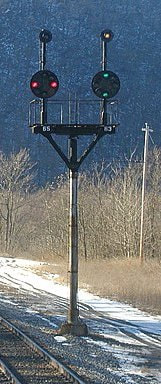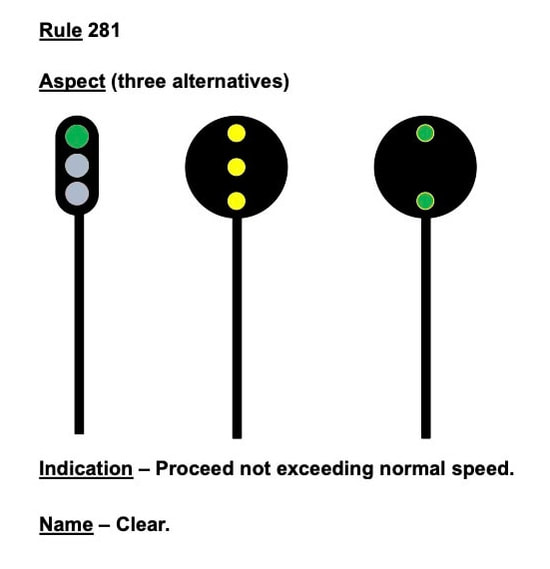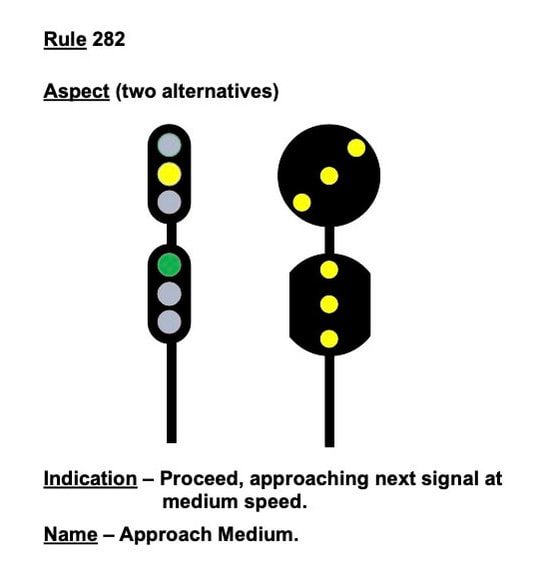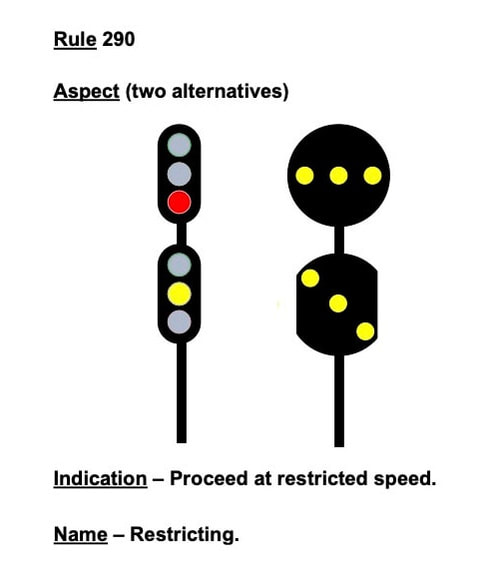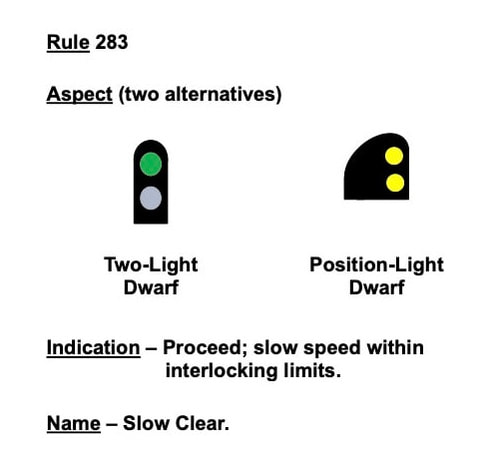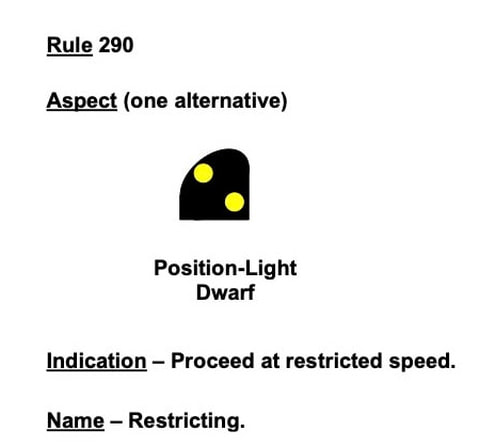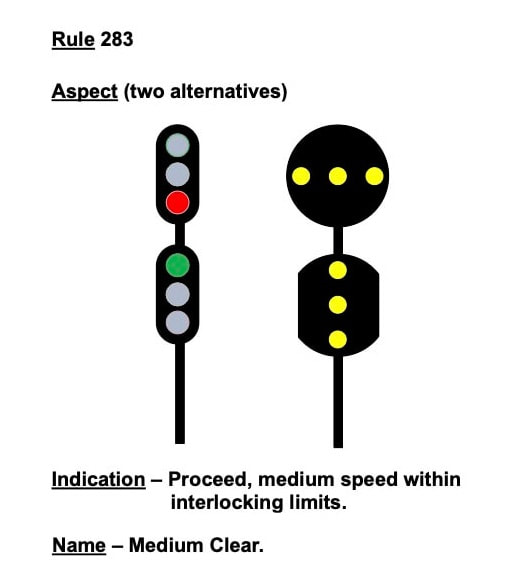Layout
Railroad Signal Systems
Introduction
In this section, we present the basics of Track Signal Systems and how they are used. For more a historical view, see Railway Age. For information on more modern signaling, see Encyclopedia Britannica and Wikipedia.
Signal System Objective
The basic objective of railroad signal systems is to maintain safe separation between trains.
Basic Approach
Dictate speeds of trains through specific sections (blocks) of track. Eastern U.S. railroads (railroads east of the Mississippi River) typically use speed only. Western U.S. railroads include some indication of route.
In this section, we present the basics of Track Signal Systems and how they are used. For more a historical view, see Railway Age. For information on more modern signaling, see Encyclopedia Britannica and Wikipedia.
Signal System Objective
The basic objective of railroad signal systems is to maintain safe separation between trains.
Basic Approach
Dictate speeds of trains through specific sections (blocks) of track. Eastern U.S. railroads (railroads east of the Mississippi River) typically use speed only. Western U.S. railroads include some indication of route.
Types of Signal Systems
Automatic Block Signals (ABS) divide track into a series of blocks (sections) so that signals control entrance to each block.
Track circuits determine if the block is occupied.
Interlocking requires that a collection of turnouts and signals are mechanically or electrically operated as a unit to insure their movements are coordinated. Often a control tower is present.
Centralized Traffic Control (CTC) is a system for controlling signals and turnouts from a centralized location, often remote from the elements controlled.
Automatic Block Signals (ABS) divide track into a series of blocks (sections) so that signals control entrance to each block.
Track circuits determine if the block is occupied.
Interlocking requires that a collection of turnouts and signals are mechanically or electrically operated as a unit to insure their movements are coordinated. Often a control tower is present.
Centralized Traffic Control (CTC) is a system for controlling signals and turnouts from a centralized location, often remote from the elements controlled.
Signals and Traffic Flow
Current of Traffic – The normal or usual direction of traffic in a block or section of blocks. Trains that move in the normal direction are said to move in the "with" direction. Trains moving in the opposite direction are said to move in the "against" direction.
Some signal systems control flow both with and against the Current of Traffic. The Shannondell Model Railroad High Line is signaled for both directions.
Other signal systems only control traffic in the Current of Traffic ("with") direction.
Dark Territory specifies track without signals.
Current of Traffic – The normal or usual direction of traffic in a block or section of blocks. Trains that move in the normal direction are said to move in the "with" direction. Trains moving in the opposite direction are said to move in the "against" direction.
Some signal systems control flow both with and against the Current of Traffic. The Shannondell Model Railroad High Line is signaled for both directions.
Other signal systems only control traffic in the Current of Traffic ("with") direction.
Dark Territory specifies track without signals.
Interlocking
Interlocking is a method for insuring that a set of turnouts and signals operate in such a way that conflict between trains is prevented and so that the route of a train through the turnouts corresponds with the train's orders and remains locked until the train either exits the interlocking or its permission to proceed is revoked. For example, in the following illustration, if a train is on the right-most track approaching
Interlocking is a method for insuring that a set of turnouts and signals operate in such a way that conflict between trains is prevented and so that the route of a train through the turnouts corresponds with the train's orders and remains locked until the train either exits the interlocking or its permission to proceed is revoked. For example, in the following illustration, if a train is on the right-most track approaching

Two tracks (right and center) together with the turnouts and signals constitute an interlocking on the Shannondell Model Railroad High Line. If a train approaching the nearer signal on the right-most track is routed to enter the siding at upper left, the four turnouts are set and locked to permit this movement and the signals will show the proper indications for this movement.
the signal and the signal is indicating "safe to proceed" the train is cleared to move to the siding at left rear in the illustration. Note that the left-most track cannot be reached by a train on any of the other tracks.
The following illustrations shows the interlockings on the Shannondell Model Railroad High Line.
Definitions
• Rule - A numbered provision of a recognized set of rules (see FRA for example) for conducting transportation on a specific railroad that defines a signal's particular aspect, its name and the associated indication.
• Aspect - The physical appearance of a signal such as color of lights and the geometric arrangement of lights to indicate a specific rule.
• Indication -The meaning of the signal aspect, such as, "Proceed not exceeding Normal Speed" or "Stop".
• [Aspect]Name - The formal name of the aspect. It is essentially a short form of the indication conveyed by the aspect. Examples are: "Clear", "Approach" and "Stop".
Speed Nomenclature Used in Signaling
• Normal - The maximum speed allowed for a specific
section of track. Can be different for passenger trains
versus freight trains.
• Limited - Varies, but typically 45 mph.
• Medium - Varies, but typically 30 mph.
• Slow - Varies, but typically 15 mph.
• Restricted - Commonly defined as speed at which a train can
stop in "half the visual range". Typically 15-20 mph.
Signals
Signals come in a variety of sizes, styles and configurations. They are mounted on masts, bracket masts, signal bridges and other mounting devices as suggested in the following illustrations.
Signals come in a variety of sizes, styles and configurations. They are mounted on masts, bracket masts, signal bridges and other mounting devices as suggested in the following illustrations.
Signal heads can take a variety of shapes and may use lights positioned in specific ways to aid in specifying indication. The following illustration shows some examples.
Many of the various types of signal heads may be found on the same railroad, mainly as a result of mergers and acquisitions.
Each railroad has it’s own set of rules as to what specific signals indicate and how engineers are to follow them.
The following three illustrations present examples of signals implementing selected rules.
Some aspects require multiple head signals, as shown in the following illustrations.
Dwarf Signals
Smaller (low to ground) signals are typically used for sidings, yards or other locations where limited sight distance is needed. Specific rules apply.
The following four illustrations present examples of dwarf signals implementing selected rules.
Signals Indicating Route
Railroads are sometimes classified as western or eastern, with the Mississippi River as the putative dividing line. In terms of signaling, western railroads often use signals not only to indicate speed, but also route. This necessitates the use of multi-head signals. In the following illustration, the top head relates to the through route (e.g.,
main line or highest speed line), the second head relates to the primary diverging route and the third head relates to the secondary diverging (lowest speed) route. A single non-red head identifies the active route. The indication for the active route may be Clear or Approach, as shown in the above illustration.
Eastern railroads sometimes identify routes by using certain aspects only when a diverging route is active, as shown below.
Signaling has changed considerably over the past 200 years, from hand-held flags to fully automated control. Some basic information on railroad signals may be found in Trains Magazine. For mid-20th Century signaling, see American Railway Signaling Principles and Practices, Chapter II: Symbols, Aspects and Indications; January 1, 1929, American Railway Association (available through Amazon.com). See also Book Of Rules for Conducting Transportation. C.T. 400; The Pennsylvania Railroad; 1956, 132 pp.
For model railroading, see JMRI Signaling. This is a fairly comprehensive treatment of both prototype and model signaling.
Shannondell Model Railroad
Now that the SMR has finished signals for the High Line, it is time to undertake signaling for the Low Grade line. Among the questions to be resolved are:
• What kind of signal, three-color or position-light signals?
• Signal in both directions or only in the current-of-traffic direction?
• Use double head signals entering Shannondell Station?
• How much can be accomplished each year?
Time will tell.



